5 OCNWDAF Services
This chapter describes the OCNWDAF services.
5.1 Analytics Subscription Service
The Analytics Subscription Service handles the subscription and notification functions in the OCNWDAF. The NF service consumers can subscribe or unsubscribe to the notification for different analytics information from the OCNWDAF through this service. The service is implemented as per 3GPP TS 29.520(v16.11).
The consumer NFs use the APIs for subscribing or unsubscribing and updating the existing subscription for OCNWDAF analytics events. The consumers are notified of the observed events as per the subscription request, and the notification can be:
- A single notification: Analytics Subscription Service sends only a single notification and purges the subscription.
- A periodic notification: Analytics Subscription Service receives the periodic analytics generated from the Analytics Generation Service as per the notification period specified in the subscription request. A notification is generated for the received analytics data. On receiving this notification, subscriptionId and Notification URI mapping is fetched, notification data is prepared, and a REST call is made to the Notification URI.
- A specific event notification: The Analytics Subscription Service processes the subscription request, validates the subscription information, generates the subscriptionID, and stores the subscription request in the subscription database. The Data Collection Service waits for the notification data corresponding to the observed events (such as configured thresholds breached) from the Analytics Generation Service and is invoked by using REST APIs.
The subscription can be for descriptive (KPIs and statistics) and predictive analytics (future event prediction). The subscription data is validated, and requests are stored in the subscription database.
Based on the subscription data, the Analytics Subscription Service intimates the Data Collection Service to gather data corresponding to the subscribed events from one or more NF functions.
The probable consumers of the Nnwdaf_EventsSubscription service are listed below:
- Policy Control Function (PCF)
- Network Slice Selection Function (NSSF)
- Access and Mobility Management Function (AMF)
- Session Management Function (SMF)
- Network Exposure Function (NEF)
- Application Function (AF)
- Operations, Administration, and Maintenance (OAM)
The Nnwdaf interface is used for communication between the 5G consumers and OCNWDAF in the Nnwdaf_EventsSubscription service.
5.2 Analytics Information Service
The Analytics Information Service enables the consumer NFs to request and get specific analytics from the OCNWDAF. The nwdaf-analyticsinfo service manages the functions related to the Analytics Information Service. The service is implemented according to 3GPP TS 29.520(v16.0). Analytics Information Service is a REST API based service.
Note:
This service handles only HTTP2 requests.The Analytics Information Service provides the following kinds of analytics information:
- Descriptive Analytics: If the parameters startTime and endTime specify a past time, then the request is for the statistics reports.
- Predictive Analytics: If the parameters startTime and endTime specify a future time, then the request is for the predictive analytics.
The Analytics Information Service provides analytics information corresponding to the Analytics ID in the consumer request.
The probable consumers of the Nnwdaf_AnalyticsInfo service are listed below:
- Policy Control Function (PCF)
- Network Slice Selection Function (NSSF)
- Access and Mobility Management Function (AMF)
- Session Management Function (SMF)
- Network Exposure Function (NEF)
- Application Function (AF)
- Operation, Administration, and Maintenance (OAM)
5.3 Data Collection Services
The following OCNWDAF services perform data collection:
- Data Collection Controller service: This service handles the NF instance identification for the UEs and raises subscription requests to various NFs for NF data (if OCNADD is not the assigned data source for the given data collection category). The NF data includes session or location information. It also receives notifications from the NFs for the subscribed events and enables the OCNWDAF to obtain appropriate data with proper granularity.
- Data Collection service: This service collects data and streams data to the CAP4C analytics engine for further processing. It also retrieves behavior data for individual UEs or groups of UEs and global UE information.
Data is collected from the sources listed below for different types of analytics:
- Global management data configured by the service provider.
- NF's data available in the 5G network.
- Data available in the individual NFs (for example, UE or UE group information).
- Oracle Communications Network Analytics Data Director (OCNADD).
The operator can configure the OCNWDAF to collect analytics information from the NFs for upcoming analytics requests. The operator defines the volume and maximum data storage. If the OCNWDAF has collected sufficient data to provide the requested information, it can skip the data collection procedure. The OCNWDAF can send an error response to the analytics consumer if the requested analytics are not available with the OCNWDAF.
Data Collection Workflow
The following workflow depicts the data collection procedure:
Figure 5-1 Data Collection

- The OCNWDAF invokes an analytics subscription (or analytics information) request to the Data Collection Controller service. The Ingress Gateway service forwards the request to the Data Collection Controller service.
- The Data Collection Controller sends an NRF Discovery request to the NRF. The NRF responds with an NF profile list based on the subscription request.
- The Data Collection Controller invokes a subscription request to the required NF from the profile list. The Egress Gateway routes the request to the NF.
- The NF response is routed back to the Data Collection Controller through the Ingress Gateway. The Ingress Gateway forwards the response to the Analytics Subscription (or Analytics Information) service.
- The NF sends data collection notification to the Data Collection Service, the notification is routed to the Data Collection Service through the Ingress Gateway.
- The data received by the Data Collection service is sent to the CAP4C for further processing.
The collected data helps in computing predictive and descriptive analytics based on the AnalyticsID. Following AnalyticsIDs are supported:
- UE Mobility
- Slice Load Level
- Abnormal behavior (unexpected UE location and Geofence movements)
- NF Load
- Network Performance
- User Data Congestion
- QoS Sustainability
Data Collection from NFs
The following call flow depicts the data collection procedure from various NFs:
Figure 5-2 Data Collection from NFs
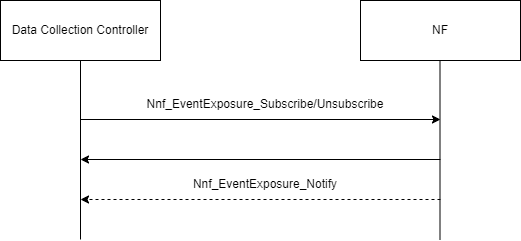
- The Data Collection Controller Service enables the OCNWDAF to subscribe or unsubscribe to an Event ID (or a set of Event ID(s)) by invoking the Nnf_EventExposure_Subscribe or Nnf_EventExposure_Unsubscribe service operation.
- The NFs notify the OCNWDAF with requested analytics (for example, event report) by invoking the Nnf_EventExposure_Notify service operation.
The following event exposure services enable OCNWDAF data collection:
Table 5-1 Exposure Services
| Service producer | Service |
|---|---|
| AMF | Namf_EventExposure |
| SMF | Nsmf_EventExposure |
| UDM | Nudm_EventExposure |
| NEF | Nnef_EventExposure |
| NRF |
Nnrf_NFDiscovery Nnrf_NFManagement |
Data Collection from NRF
The OCNWDAF uses the NRF NF discovery service (Nnrf_NFDiscovery) to dynamically discover NF instances and their services in the 5G Core (5GC). This activity can be periodic or based on any specific event in the network. The OCNWDAF also utilizes the NRF MF Management Service (Nnrf_NFManagement), NFStatusSubscribe (NFStatusSubscribe), and NFStatusNotify services to obtain information about change in NF status. The information collected by these NRF services is used for obtaining NF Load analytics and maintaining a network map for data collection.
Note:
The Nnrf_NFDiscovery service is invoked only after NFStatusSubscribe service to eliminate race conditions of NF status change after the NRF discovery but before the NRFStatusSubscribe service.NRF NFStatusSubscribe Service
The NFStatusSubscribe service is used to create an OCNWDAF subscription to the NRF. The OCNWDAF gets notified by the NRF when a specific NF instance profile or set of NF instance profiles are modified or deregistered in the NRF.
Figure 5-3 NF Status Subscribe

- The OCNWDAF invokes the NFStatusSubscribe service to receive notifications about events (such as registration, deregistration, profile change) related to the Target NF located in the same PLMN by a POST request to the NRF.
- The NRF authorizes or rejects the subscription request based on the validity of attributes in the POST request.
- If the request is successful, a subscription is created and a HTTP response code "201 Created" is returned to the OCNWDAF.
- If the request fails an appropriate HTTP response code is returned (4xx, 5xx or 3xx) indicating the reason for the failure.
NRF NFStatusNotify Service
This service operation notifies the OCNWDAF subscribed to NRF about registration (or deregistration) and profile changes of target NF (or NF instances).
Figure 5-4 NF Status Notify
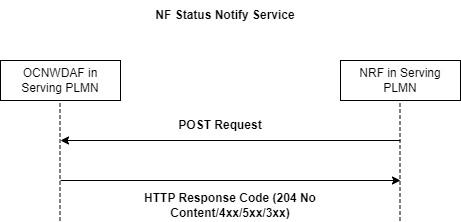
- The NRF invokes the NFStatusNotify service POST request to the subscribed OCNWDAF to indicate any registration or profile changes in the target NF (or NF instances).
- If the request is successful, the OCNWDAF responds with a "204 No content" HTTP response code.
- If the request fails an appropriate HTTP response code is returned (4xx, 5xx or 3xx) indicating the reason for the failure.
NRF NFDiscover Service
This service is used to obtain a set of NF instances (represented by their NF profile) that are currently registered with the NRF based on the input query parameters. The results are obtained in the SearchResult format. The information obtained is stored for further processing to obtain NF load analytics.
Figure 5-5 NF Discovery Service
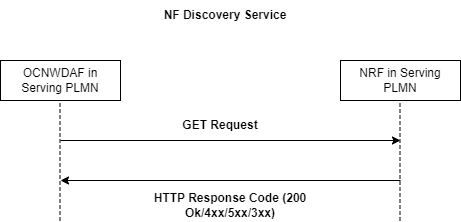
- The OCNWDAF invokes the NFDiscover service GET request with query parameter "nf-instances" to the NRF.
- If the request is successful, the NRF responds with a "200 OK" HTTP code with the response body containing the requested NF profile information based on the request query.
- If the request fails an appropriate HTTP response code is returned (4xx, 5xx or 3xx) indicating the reason for the failure.
Data Collection from Operations, Administration, and Maintenance (OAM)
The OCNWDAF subscribes to the OAM for the data required to compute analytics information. The OAM processes the request and provides the requested data to the OCNWDAF.
The following call flow depicts the data collection procedure from the OAM:
Figure 5-6 Data Collection from OAM
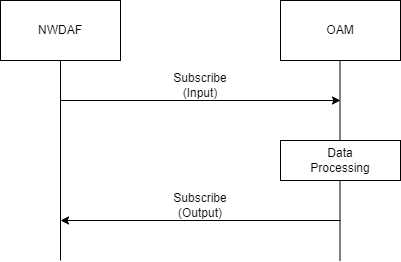
- OCNWDAF subscribes to the notifications related to the services provided by the OAM.
- Based on the subscription request from OCNWDAF, the OAM performs data processing and prepares the data to be shared with the OCNWDAF.
- OCNWDAF obtains the requested data from the OAM.
Data Collection from OCNADD
The Oracle Communications Network Analytics Data Director (OCNADD) can be configured as a data collection source for the OCNWDAF. For more information, see Data Director (OCNADD) Integration.
Figure 5-7 Data Collection from OCNADD

- The analytics consumer sends an analytics request to the OCNWDAF . The analytics request is either an analytics subscription request (Nnwdaf_AnalyticsSubscription_Subscribe) or an analytics information request (Nnwdaf_AnalyticsInfo_Request).
- The OCNWDAF collects the required data such as cell location or session information from the OCNADD.
- The OCNWDAF derives the required analytics from the Analytics Engine CAP4C.
- The OCNWDAF sends the analytics information to the analytics consumer through a Nnwdaf_AnalyticsSubscription_Notify or Nnwdaf_AnalyticsInfo_Request message.
The data collected helps in computing analytics based on the AnalyticsID. Listed below are the AnalyticsIDs supported when the data collection source is configured as OCNADD:
- UE Mobility
- Slice Load Level
- Abnormal Behavior (unexpected UE location)
5.4 Capex Optimization Service
The Capex Optimization service interfaces between the Portal Service and the Analytics DB Service to facilitate configuration of Capex Groups and generation of Capex metrics information.
Capex Service
The following diagram displays the workflow adopted for creating Capex groups:
Figure 5-8 Capex Service
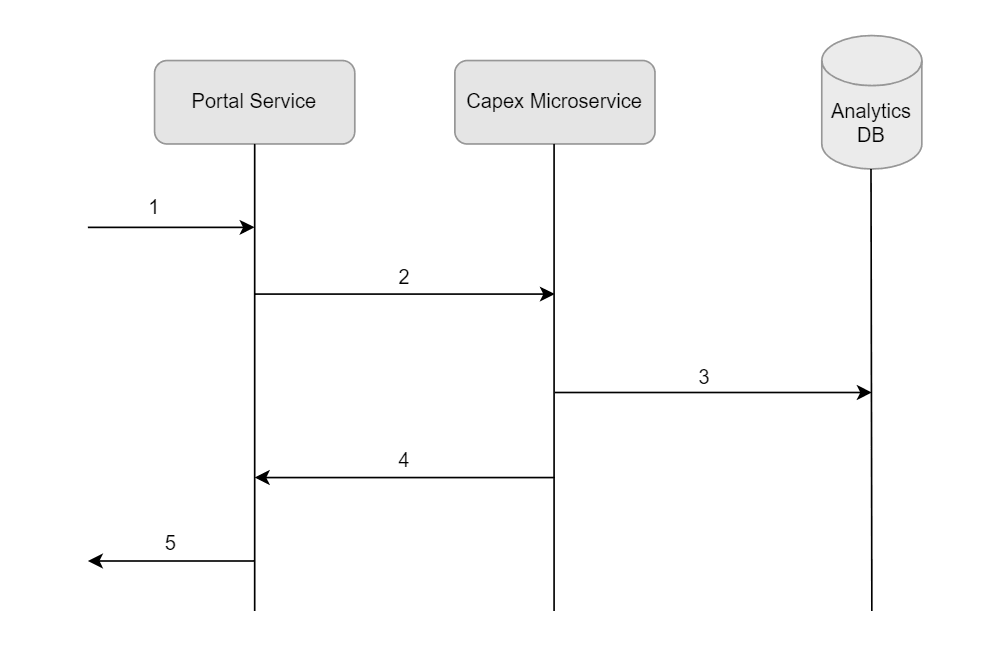
- User raises a request to create a Capex group on the Portal Service (or GUI) by providing information required to create a Capex group.
- The Portal Service (GUI) requests to the Capex Optimization Microservice to create the group.
- The Capex Optimization Microservice processes this data and stores it in the Analytics DB.
- The Capex group is successfully created and the Capex Microservice sends a success message to the Portal Service (GUI).
- The Portal Service (GUI) displays the newly created Capex group and the corresponding analytics for that Capex group.
To view Network Performance and User Data Congestion Prediction per Capex Group, see Machine Learning (ML) Model Selector.
To access the Capex Optimization page, create Capex groups and view Capex Metrics on the OCNWDAF GUI, see Capex Optimization.